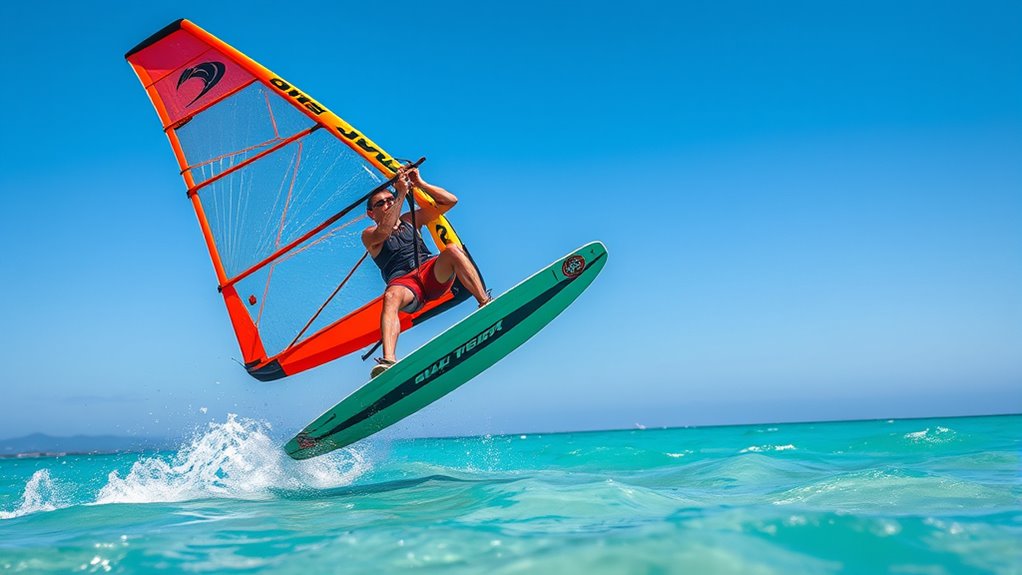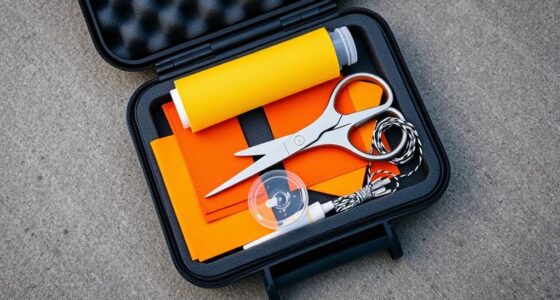To generate lift in low wind, focus on maintaining a streamlined body position and proper hydrodynamic flow. Use smooth, rhythmic pulls from your shoulders and core muscles, keeping your paddle angles correct for efficient water transfer. Engage your entire body for powerful, controlled movements, avoiding jerky motions that waste energy. Consistent technique and steady timing help minimize turbulence and maximize propulsion—by mastering these perfectly coordinated strokes, you’ll release more lift even in calm conditions.
Key Takeaways
- Maintain a steady, rhythmic paddling motion to ensure smooth water flow and continuous lift generation.
- Use proper paddle angles to optimize water engagement and reduce turbulence for efficient lift.
- Engage core muscles and initiate movements from shoulders and torso for maximum hydrodynamic efficiency.
- Keep body aligned and stable to minimize drag and facilitate effective energy transfer.
- Focus on consistent technique and controlled pulls to sustain lift, especially in low wind conditions.

Have you ever wondered how proper pumping technique can make a difference in your results? When you’re trying to generate lift in low wind conditions, understanding the hydrodynamic principles behind your actions is vital. Your goal is to maximize mechanical efficiency, guaranteeing every movement contributes effectively to moving water and creating lift. The core idea is to transfer as much energy as possible from your body into the water, and that begins with how you approach each pump.
First, focus on the shape and movement of your paddle or blade. Hydrodynamic principles tell us that a streamlined profile reduces drag and allows you to cut through water more smoothly. When you pull or push, keep your blade angled correctly—usually slightly tilted to optimize water flow and minimize resistance. This positioning helps you harness the water’s resistance rather than fight against it, guaranteeing your effort translates into effective propulsion.
Next, pay attention to your stroke technique. Efficient pumping relies on continuous, smooth motions rather than jerky or uneven pulls. Start your stroke with a strong, controlled pull that engages your core muscles, not just your arms. This engagement maximizes mechanical efficiency by utilizing larger muscle groups, reducing fatigue, and transmitting more force into the water. As you pull, maintain a steady speed, avoiding abrupt stops or changes in rhythm, which can cause energy loss through turbulence and unnecessary drag.
Your timing is also critical. Hydrodynamics favor a fluid, rhythmic motion that mirrors natural water flow. Coordinate your pulls so that each one transitions seamlessly into the next, creating a continuous flow that sustains lift even in low wind. This steady rhythm minimizes the formation of turbulent eddies that waste energy and decrease efficiency. When you accelerate or decelerate abruptly, you disrupt the hydrodynamic flow, reducing your overall mechanical efficiency.
Finally, consider your body position. Keep your body aligned and stable, with your core engaged and your movements originating from your shoulders and torso rather than just your arms. This stance allows you to leverage your entire body’s strength, enhancing the hydrodynamic flow around your paddle or blade. By doing so, you reduce unnecessary drag and guarantee your energy is channeled into generating lift efficiently.
In addition, practicing proper technique can help you develop muscle memory, leading to more consistent and effective pumping over time. Mastering these hydrodynamic principles is key to improving your overall mechanical efficiency, ensuring every effort you make contributes to better lift and sustained performance. By focusing on smooth, controlled movements, correct paddle angles, and body positioning, you’ll make every effort count. This thoughtful approach not only boosts your lift in low wind conditions but also conserves your energy, making your pumping more effective and sustainable over time.
Frequently Asked Questions
How Can I Improve My Pumping Efficiency in Minimal Wind?
To improve your pumping efficiency in minimal wind, focus on mastering aerial techniques that maximize lift with limited airflow. Study wind patterns to position yourself ideally, ensuring you catch the most favorable gusts. Use smooth, consistent movements to generate momentum, and stay patient while waiting for the right moment. By understanding wind behavior and refining your technique, you’ll increase your lift and overall performance even in low wind conditions.
What Equipment Modifications Enhance Lift Generation During Low Wind?
To enhance lift during low wind, you should consider equipment modifications like choosing a kite with a more efficient kite design and an optimized wing shape. A kite with a larger surface area and a high aspect ratio can generate more lift at lower wind speeds. Additionally, adjusting the bridle and sail tension can improve airflow, making your pumping more effective. These tweaks help you maximize lift with minimal wind.
Are There Specific Body Positions That Maximize Pumping Effectiveness?
Perfectly poised for pumping power, your body stance and limb extension play pivotal roles. Position your feet shoulder-width apart, keep your core engaged, and lean slightly forward to optimize balance. Extend your arms fully during each pump, then retract smoothly. This stance and precise limb extension maximize momentum, making your efforts more effective. Consistent, controlled movements with proper body positioning boost your lifting lift, especially when wind whispers weakly.
How Does Atmospheric Pressure Influence Low Wind Pumping Techniques?
Atmospheric pressure plays a key role in low wind pumping techniques. You can maximize your efforts by understanding how pressure differential impacts air movement; higher pressure differences create more lift. Additionally, air density influences efficiency—denser air offers more resistance, making it easier to generate lift. By adjusting your body position and timing your movements, you help leverage these factors, improving your overall pumping performance in low wind conditions.
What Safety Precautions Should I Consider When Pumping in Low Wind Conditions?
When pumping in low wind conditions, you should prioritize safety by monitoring humidity control to prevent equipment corrosion and overheating. Regular equipment maintenance is essential to guarantee everything functions smoothly and reduces risks. Be cautious of fatigue, stay aware of your surroundings, and avoid overexertion. Using proper protective gear and following safety protocols helps prevent accidents, ensuring your pumping process remains safe and efficient despite the low wind environment.
Conclusion
Now that you know the basics of pumping technique, you’re ready to generate lift even in low wind conditions. Remember, practice makes perfect, and adjusting your timing and effort can make all the difference. So, next time you hit a calm moment, will you seize the chance to master your skills and keep your kite soaring? With patience and persistence, you’ll turn those quiet days into your greatest opportunities. Ready to take your flying to the next level?










